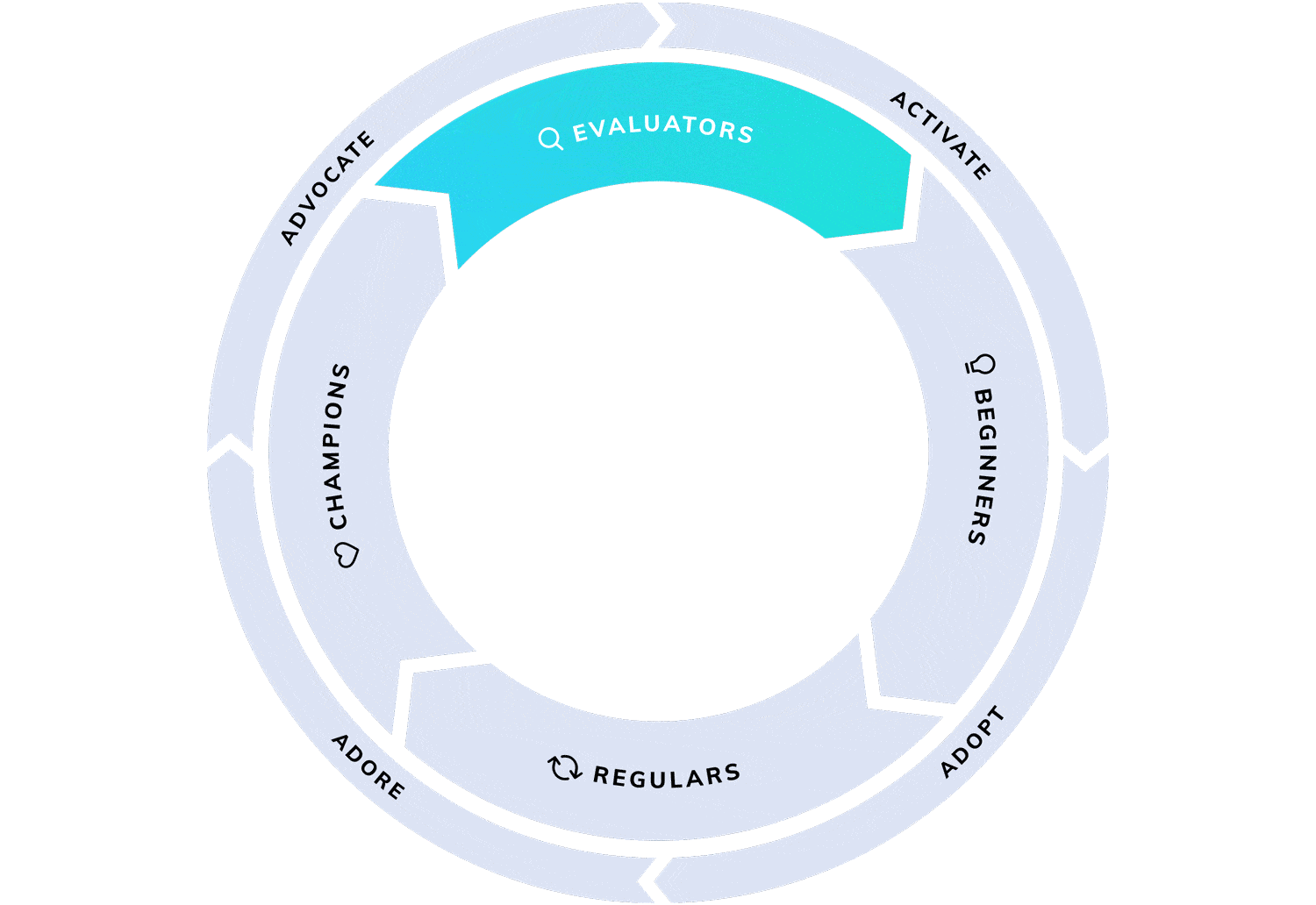The Product-Led Growth Flywheel
The Product-Led Growth Flywheel
SaaS businesses have been using Dave McClure’s Pirate Metrics framework for over a decade now. But the pirate metrics were developed in 2007.
What is the Product-Led Growth Flywheel?

Product-Led Growth Flywheel In this framework, the experience is designed to generate higher user satisfaction and increased advocacy, which in turn drives compounding growth of new user acquisition.
It depicts 4 sequential user segments that correlate with stages in the user journey from awareness to evangelism—evaluator, beginner, regular, and champion—and the key actions that users need to take to graduate to the next stage—activate, adopt, adore, and advocate.
Methodology
We interviewed over 50 companies covering a range of sizes and business models—from direct-to-consumer companies with over 500 employees to B2B SaaS businesses with fewer than 10.
The Product-Led Growth Flywheel
Evaluators
Evaluators 评估者 Evaluators are typically:
- In a trial or demo phase—they’ve just started playing around with your product
- Not installed or using real data
- Not using your product in their current workflows
- Still searching for a solution to a problem they are trying to solve
What they want from your product
Evaluators want to know that you understand their problem and can offer them a clear path to solving it.
How to deliver value
In short, guide evaluators to their Aha Moment.
The goal is to guide evaluators to value and get them to activate.
Activate
Activate Activation looks different for every company. But at its core, activation is a feeling that the user experiences.
Once you’ve identified the activation events within your product, your goal should be to help your users get there quickly and minimize their Time-to-Value.
Who is responsible for activation?
growth, product, or customer success team member Once a user has activated through these combined efforts, they progress in their user journey and graduate to the beginner stage of the flywheel.
Beginners
Beginners Beginners understand how your product can meet their needs and deliver value—and they’re excited about it!
Beginners are typically
- Incorporating your product into their workflows
- Starting to use real data and receiving tangible value
- Not using advanced functionality or implementing sophisticated use cases
- Feeling confident that your product is the best solution to solve their problem
What they want from your product
Beginners are starting to demonstrate signs of commitment. They’re eager to learn more to discover additional benefits your product may provide beyond the use case that initially brought them to you.
How to deliver value
your focus should be on helping users build on the foundational knowledge they achieved as evaluators, discover additional features that may address secondary problems or make their workflow more efficient, and generally connect the dots between your product and their day-to-day.
The goal is to get users to fully adopt your product through habitual, more advanced usage.
Adopt
Adopt Adoption is about forming habits and getting users to associate your product with a specific task or solution. Users who have adopted your product don’t put a lot of thought into deciding to use your product regularly, they just use it.
Who is responsible for product adoption?
Product, support, and customer success
When users adopt successfully, they move through the flywheel and become regular users of your product.
Regulars
Regular users are typically:
- Logging in on a regular basis
- Using your product to complete core parts of their job
- Defaulting to your product as a possible solution when new problems arise
- Exploring deeper layers of your product to see what else your product help them do
What they want from your product
Regulars want to enjoy using your product—they use it frequently, after all—and they are easily frustrated by friction.
These users are often searching for new ways to obtain value from your product, either through new use cases or through efficiencies that save them time on existing tasks.
Regulars are also likely curious about how your product will grow with them to address their evolving needs.
How to deliver value
Educational content is another great way to engage users at this stage of their journey.
Don’t bombard regulars with too much communication, but do check up on them to make sure that they are having a delightful product experience.
The goal here is more than just habitual usage or product adoption—it’s emotional. To move users through the flywheel, you need them to adore your product.
Adore
Adore Users who adore your product don’t just use it frequently—they enjoy using it, look forward to accomplishing tasks, and have a real desire to expand into new use cases.
Who is responsible for getting users to adore your product?
Every team in your company should be concerned
When a user truly adores your product, they graduate to the ultimate stage of the user journey and become a champion.
Champions
Champions Champions are typically:
- Actively participating in the future of your product
- Pushing the limits of your product with new use cases
- NPS promoters
- Wearing your brand’s t-shirt
What they want from your product
Champions enjoy feeling like a partner or friend to your business. They want to actively participate in your future because they are invested in it.
How to deliver value
Let them know the feeling is mutual. Offer them swag, advanced guidance, power-use features, and first dibs on beta versions.
When thinking through the Product-Led Growth Flywheel, the goal at this point is clear—you want your champions to advocate.
Advocate
Advocate Advocacy—inviting other users to your product, leaving reviews, actively evangelizing—drives awareness and evaluator interest in your product, completing the cycle and leading to compounding growth.
Who is responsible for encouraging advocacy?
Who is responsible for encouraging advocacy?
Next steps
This flywheel isn’t the only flywheel—and it doesn’t have to be.